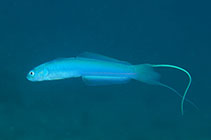| Family: |
Microdesmidae (Wormfishes), subfamily: Ptereleotrinae |
| Max. size: |
12 cm TL (male/unsexed) |
| Environment: |
reef-associated; marine; depth range 3 - 50 m |
| Distribution: |
Pacific Ocean: Philippines to the Line Islands, north to southern Japan, south to northwestern Australia and New South Wales. |
| Diagnosis: |
Dorsal spines (total): 7-7; Dorsal soft rays (total): 24-26; Anal spines: 1-1; Anal soft rays: 22-25; Vertebrae: 26-26. Pale blue to light bluish gray in color. Operculum with 2 broad, curved, bright blue bands. 4 to 6 median barbels (like bumps in juveniles). 2nd spine of 2nd dorsal fin elongated; caudal fin of adults with trailing filaments; diagonally elongate red to violet spot usually present on lower base of pectoral fin. |
| Biology: |
Inhabits coastal reef slopes in a depth range of about 6 to 30 meters depth (Ref. 48637). Found over rubble and sand near reefs. Usually seen in pairs occupying the same burrow. It uses burrows made by alpheid shrimps which live in association with gobies of the genus Amblyeleotris, but does not interact with the shrimps. Feeds on zooplanktons (Ref. 89972). |
| IUCN Red List Status: |
Least Concern (LC); Date assessed: 12 March 2015 Ref. (130435)
|
| Threat to humans: |
harmless |
Source and more info: www.fishbase.org. For personal, classroom, and other internal use only. Not for publication.
